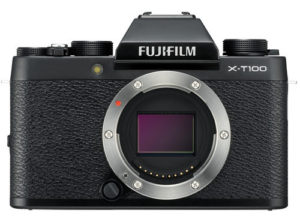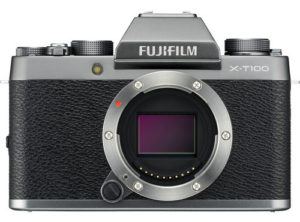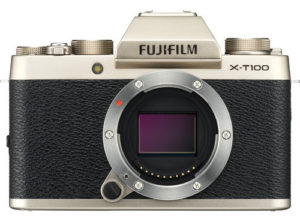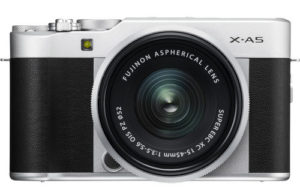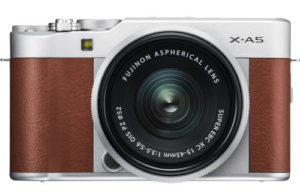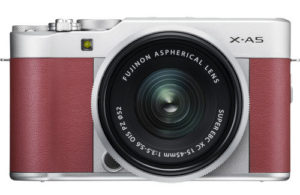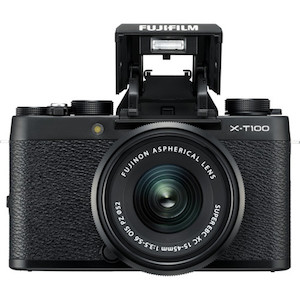Up until recently, anyone looking for a small, light and affordable X-Series camera was limited to the X-A series. Then, Fujifilm announced the X-T100, an entry-level model which inherits the best features from the latest X-A cameras while retaining the built-in viewfinder that characterises the X-T series.
In this comparison preview, we’re going to be taking a look at the various ways in which the Fujifilm X-T100 differs from the latest model in the X-A series, the Fujifilm X-A5. We hope you find it useful!
Main characteristics they share:
- 24.2MP APS-C Bayer sensor
- ISO range of 200 to 12800 with 100, 25600 and 51200 extended values
- mechanical (30s – 1/4000s) and electronic shutter (30s – 1/32000s)
- continuous shooting speeds of 6fps and 3fps
- hybrid AF system (contrast and phase detection) with 91 areas and single point, zone AF and wide/tracking AF options
- 4K Burst and Multi Focus Mode
- hot shoe with TTL flash compatibility
- built-in pop-up flash
- WiFi and Bluetooth
Ethics statement: The information supplied in this article is based upon official specifications and our personal experience with the X-A5 and other Fujifilm cameras. We were not asked to write anything about these cameras, nor were we provided with any sort of compensation. Within the article, there are affiliate links. If you decided to buy something after clicking the link, we will receive a small commission. To know more about our ethics, you can visit our full disclosure page. Thank you!
1. Design
When you look at the X-T100, you can immediately tell it belongs to the X-T family thanks to its SLR-like design. In fact, it greatly resembles a stripped-down version of the X-T20. The body is wrapped in a black faux leather covering and the anodised aluminium top plate comes in three colour variations: black, dark silver and champagne gold.
The X-A5 by contrast definitely has the look of a rangefinder camera due to the lack of a viewfinder on top. It is mostly made of plastic with the exception of the metallic top plate and you have a choice between in black, pink or brown for the faux leather covering.
On the top plate, you’ll notice that both cameras have a PSAM dial, control dial and on/off switch. However only the X-T100 has an extra function dial on the left that is completely customisable according to Fujifilm ambassador Jonas Rask. In the “DEFAULT” setting, the dial is automatically assigned to the best options for each shooting mode.

2. Front grip
Another minor difference is that the X-A5 has a small built-in grip out front whereas the X-T100 kit includes an optional grip that attaches via a plug to the camera body. The additional grip is said to improve the handling but you can choose not to attach it if you want to keep the camera as streamlined as possible.
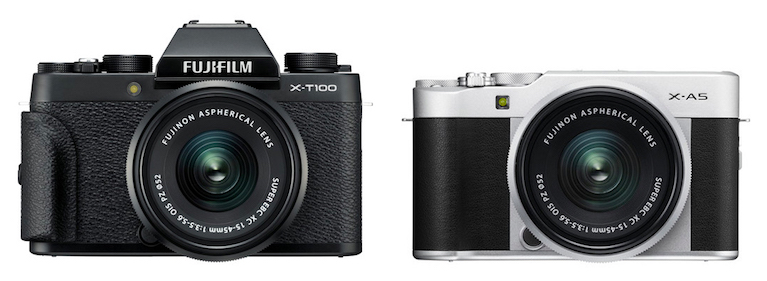
3. Size and weight
Although the X-T100 is smaller and lighter than most other X-T cameras, it remains larger and heavier than the X-A5 partially due to the protruding viewfinder. You can see the exact measurements below:
- X-T100: 121 x 83 x 47.4 mm | 448g including the battery and SD card
- X-A5: 116.9 x 67.7 x 40.4mm | 361g including the battery and SD card
4. Viewfinder
Probably the most significant difference between the two cameras is that the X-T100 has a built-in electronic viewfinder whereas the X-A5 does not.
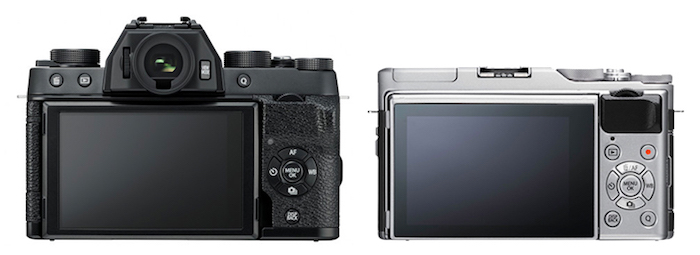
The OLED viewfinder is a 0.39-inch type with a 2360K dots of resolution, 100% coverage, 0.62x magnification and an eye point of 17.5mm.
The advantage of having a viewfinder is that it gives you a clear view of your scene in conditions where the rear screen might be difficult to see, such as bright sunny days. At the time of writing, Fujifilm hasn’t released an external electronic viewfinder, so you don’t have the option of attaching one to the hotshoe of the X-A5.
5. LCD monitor articulation
The second biggest difference concerns how the rear LCD monitor articulates.
The screen of the X-A5 tilts upwards to 180 degrees to facilitate selfie shooting. It also tilts downwards, and while we couldn’t find any official specifications for the tilt range, it seems to be in the region of 45 degrees.
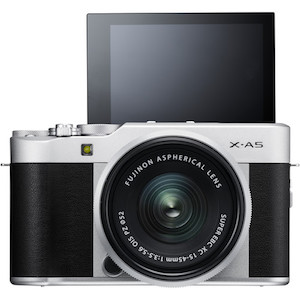
The X-T100, on the other hand, utilises a brand new three-way tilting mechanism that rotates up, down and to the side.
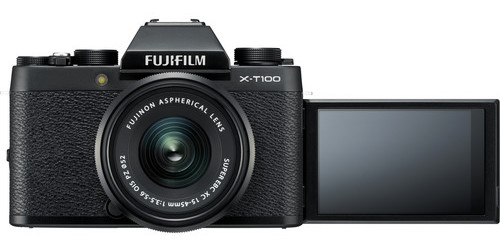
In the end, both mechanisms are suitable for selfie shooting, so it really comes down to which type of articulation you prefer.
As for the other specifications, they are identical: 3 inches in size with 1040K resolution and touch sensitivity. Touch operation includes pinch zoom, drag to move around the image and additional functions using flick gestures.
6. Autofocus algorithm
Both the X-T100 and X-A5 use a hybrid autofocus system with 91 areas. However, according to Fujifilm, the X-T100 utilises a “newly developed autofocus algorithm which offers faster and more precise focusing.”
During our testing period, we found the X-A5’s AF system somewhat unreliable – especially when paired with lenses that lack a fast AF motor – so hopefully the X-T100 brings some improvements.
7. Buffer depth
Now that we’ve got the large differences out of the way, we can start investigating the smaller ones, such as the buffer depth for example.
According to the official specifications, the X-T100 can manage 26 JPG frames in a single burst at 6fps or an unlimited number of frames at 3fps.
The X-A5 doesn’t perform as well, managing just 10 JPG frames at 6fps or 50 frames at 3fps.
Of course, the performance will vary with the shooting conditions and the type of memory card you use.
8. Pop-up flash
Although both cameras have a built-in pop-up flash, they are found in different locations on the body. That of the X-A5 is found on the top-left whereas the X-T100’s is positioned on the viewfinder.
The X-T100 also has a slightly higher guide number of 5 at ISO 100, compared to 4 on the X-A5.
9. Video recording time
Both cameras are capable of filming in 4K at 15fps or Full HD at 60fps. They also share a High Speed movie mode that allows users to record HD video up to quad speed for slow motion clips.
With the X-T100, the recording time is 30 minutes regardless of whether you choose 4K or Full HD resolution. It is the first model in the X-series line-up that raises the recording limit to the default 30 minutes, which is welcome but a little bit surprising when you consider that the video-oriented X-H1 is capped at 15 minutes.
By contrast, the X-A5 is limited to just 5 minutes of continuous recording in 4K or 14 minutes in Full HD. You can see some example 4K footage taken with the X-A5 by watching the video below.
10. Price
Although the X-A5 and X-T100 are both classified as entry-level models, the X-T100 remains a step above its sibling because of the built-in viewfinder. As a result, it is also a little more expensive at around $699 / £620 with the kit lens.
The X-A5 hasn’t been on the market for very long, so don’t expect a price drop just yet. It can usually be found for approximately $600 / £530 with the kit lens.
Conclusion
Most of our other comparison previews finish with us balancing the various pros and cons of one model against the other, but in the case of the X-T100 and X-A5, the conclusion is far more straightforward.
If you feel you need a built-in viewfinder and want to pay as little for an X-Series camera as possible, the new X-T100 is definitely the best way to go. Other perks include the 30 minute recording limit and the LCD screen’s three-way tilting mechanism for selfie shooting.
On the other hand, those who aren’t bothered by using the rear screen to compose will probably get just as much out of the X-A5 and save some money in the process.
Check price of the Fujifilm X-T100 on
Check price of the Fujifilm X-A5 on

